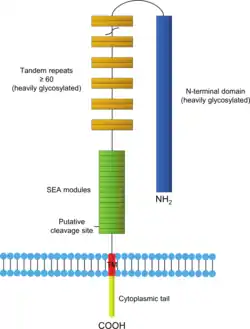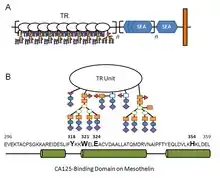Mucin-16
Mucin-16 (MUC-16) also known as Ovarian cancer-related tumor marker CA125 is a protein that in humans is encoded by the MUC16 gene.[3][4][5] MUC-16 is a member of the mucin family glycoproteins.[6] MUC-16 has found application as a tumor marker or biomarker that may be elevated in the blood of some patients with specific types of cancers, most notably ovarian cancer, or other conditions that are benign.[7][8]
| MUC16 | |||||||||||||||||||||||||||||||||||||||||||||||||||
|---|---|---|---|---|---|---|---|---|---|---|---|---|---|---|---|---|---|---|---|---|---|---|---|---|---|---|---|---|---|---|---|---|---|---|---|---|---|---|---|---|---|---|---|---|---|---|---|---|---|---|---|
 | |||||||||||||||||||||||||||||||||||||||||||||||||||
| Identifiers | |||||||||||||||||||||||||||||||||||||||||||||||||||
| Aliases | MUC16, CA125, mucin 16, cell surface associated | ||||||||||||||||||||||||||||||||||||||||||||||||||
| External IDs | OMIM: 606154 HomoloGene: 133291 GeneCards: MUC16 | ||||||||||||||||||||||||||||||||||||||||||||||||||
| |||||||||||||||||||||||||||||||||||||||||||||||||||
| |||||||||||||||||||||||||||||||||||||||||||||||||||
| |||||||||||||||||||||||||||||||||||||||||||||||||||
| |||||||||||||||||||||||||||||||||||||||||||||||||||
| Wikidata | |||||||||||||||||||||||||||||||||||||||||||||||||||
| |||||||||||||||||||||||||||||||||||||||||||||||||||
Structure
Mucin 16 is a membrane associated mucin that possesses a single transmembrane domain.[9] A unique property of MUC16 is its large size. MUC16 is more than twice as long as MUC1 and MUC4 and contains about 22,000 amino acids, making it the largest membrane-associated mucin.[10]
MUC16 is composed of three different domains:[11]
- An N-terminal domain
- A tandem repeat domain
- A C-terminal domain
The N-terminal and tandem repeat domains are both entirely extracellular and highly O-glycosylated. All mucins contain a tandem repeat domain that has repeating amino acid sequences high in serine, threonine and proline.[12] The C-terminal domain contains multiple extracellular SEA (sea urchin sperm protein, enterokinase, and agrin) modules,[13] a transmembrane domain, and a cytoplasmic tail.[11] The extracellular region of MUC16 can be released from the cell surface by undergoing proteolytic cleavage.[14] MUC16 is thought to be cleaved at a site in the SEA modules.[15]
Function
MUC16 is a component of the ocular surface (including the cornea and conjunctiva), the respiratory tract and the female reproductive tract epithelia. Since MUC16 is highly glycosylated it creates a hydrophilic environment that acts as a lubricating barrier against foreign particles and infectious agents on the apical membrane of epithelial cells.[16] Also, the cytoplasmic tail of MUC16 has been shown to interact with cytoskeleton by binding members of the ERM protein family.[17] The expression of mucin 16 has been shown to be altered in dry eye, cystic fibrosis, and several types of cancers.[18]
Role in cancer

MUC16 (CA-125) has been shown to play a role in advancing tumorigenesis and tumor proliferation by several different mechanisms.
As a biomarker
Testing of CA-125 blood levels has been proposed as useful in treating ovarian cancer. While the test can give useful information for women already known to have ovarian cancer, CA-125 testing has not been found useful as a screening method because of the uncertain correlation between CA-125 levels and cancer.[19] In addition to ovarian cancer, CA-125 can be elevated in patients who have conditions such as endometrial cancer, fallopian tube cancer, lung cancer, breast cancer, and gastrointestinal cancer. It can also be increased in pregnant women. Because of the wide variety of conditions that can increase serum levels, CA-125 is not used to detect cancer, but it is often used to monitor responses to chemotherapy, relapse, and disease progression in ovarian cancer patients.[20]
Metastatic invasion

MUC16 is also thought to participate in cell-to-cell interactions that enable the metastasis of tumor cells. This is supported by evidence showing that MUC16 binds selectively to mesothelin, a glycoprotein normally expressed by the mesothelial cells of the peritoneum (the lining of the abdominal cavity).[22] MUC16 and mesothelin interactions are thought to provide the first step in tumor cell invasion of the peritoneum.[23] The region (residues 296–359) consisting of 64 amino acids at the N-terminus of cell surface mesothelin has been experimentally established as the functional binding domain (named IAB) for MUC16/CA125.[21] An immunoadhesin (HN125) that consists of the IAB domain of mesothelin and the human Fc portion has the ability to disrupt the heterotypic cancer cell adhesion mediated by the MUC16-mesothelin interaction.[24]
Mesothelin has also been found to be expressed in several types of cancers including mesothelioma, ovarian cancer and squamous cell carcinoma.[25] Since mesothelin is also expressed by tumor cells, MUC16 and mesothelial interactions may aid in the gathering of other tumor cells to the location of a metastasis, thus increasing the size of the metastasis.[23]
Induced motility
Evidence suggests that expression of the cytoplasmic tail of MUC16 enables tumor cells to grow, promotes cell motility and may facilitate invasion. This appears to be due to the ability of the C-terminal domain of MUC16 to facilitate signaling that leads to a decrease in the expression of E-cadherin and increase the expression of N-cadherin and vimentin, which are expression patterns consistent with epithelial-mesenchymal transition.[26]
Discovery
CA-125 was initially detected using the murine monoclonal antibody designated OC125. Robert Bast, Robert Knapp and their research team first isolated this monoclonal antibody in 1981.[28] The protein was named "cancer antigen 125" because OC125 was the 125th antibody produced against the ovarian cancer cell line that was being studied.[29]
References
- GRCh38: Ensembl release 89: ENSG00000181143 - Ensembl, May 2017
- "Human PubMed Reference:". National Center for Biotechnology Information, U.S. National Library of Medicine.
- "MUC16 - Mucin-16 - Homo sapiens (Human) - MUC16 gene & protein". www.uniprot.org. Retrieved 15 June 2022.
- Yin BW, Lloyd KO (Jul 2001). "Molecular cloning of the CA125 ovarian cancer antigen: identification as a new mucin, MUC16". The Journal of Biological Chemistry. 276 (29): 27371–5. doi:10.1074/jbc.M103554200. PMID 11369781.
- Yin BW, Dnistrian A, Lloyd KO (Apr 2002). "Ovarian cancer antigen CA125 is encoded by the MUC16 mucin gene". International Journal of Cancer. 98 (5): 737–40. doi:10.1002/ijc.10250. PMID 11920644. S2CID 39365316.
- Duraisamy S, Ramasamy S, Kharbanda S, Kufe D (May 2006). "Distinct evolution of the human carcinoma-associated transmembrane mucins, MUC1, MUC4 AND MUC16". Gene. 373: 28–34. doi:10.1016/j.gene.2005.12.021. PMID 16500040.
- "CA 125 test". Mayo Clinic. Retrieved 3 January 2022.
- Bast RC, Xu FJ, Yu YH, Barnhill S, Zhang Z, Mills GB (1998). "CA 125: the past and the future". The International Journal of Biological Markers. 13 (4): 179–87. doi:10.1177/172460089801300402. PMID 10228898. S2CID 46589946.
- Gipson IK (Oct 2007). "The ocular surface: the challenge to enable and protect vision: the Friedenwald lecture". Investigative Ophthalmology & Visual Science. 48 (10): 4390, 4391–8. doi:10.1167/iovs.07-0770. PMC 2886589. PMID 17898256.
- Gniewek P, Kolinski A (Jan 2012). "Coarse-grained modeling of mucus barrier properties". Biophysical Journal. 102 (2): 195–200. Bibcode:2012BpJ...102..195G. doi:10.1016/j.bpj.2011.11.4010. PMC 3260744. PMID 22339855.
- O'Brien TJ, Beard JB, Underwood LJ, Dennis RA, Santin AD, York L (Nov–Dec 2001). "The CA 125 gene: an extracellular superstructure dominated by repeat sequences". Tumour Biology. 22 (6): 348–66. doi:10.1159/000050638. PMID 11786729. S2CID 20219942.
- Hollingsworth MA, Swanson BJ (Jan 2004). "Mucins in cancer: protection and control of the cell surface". Nature Reviews. Cancer. 4 (1): 45–60. doi:10.1038/nrc1251. PMID 14681689. S2CID 23171728.
- Kufe DW (Dec 2009). "Mucins in cancer: function, prognosis and therapy". Nature Reviews. Cancer. 9 (12): 874–85. doi:10.1038/nrc2761. PMC 2951677. PMID 19935676.
- Goodell CA, Belisle JA, Gubbels JA, Migneault M, Rancourt C, Connor J, Kunnimalaiyaan M, Kravitz R, Tucker W, Zwick M, Patankar MS (2009). "Characterization of the tumor marker muc16 (ca125) expressed by murine ovarian tumor cell lines and identification of a panel of cross-reactive monoclonal antibodies". Journal of Ovarian Research. 2 (1): 8. doi:10.1186/1757-2215-2-8. PMC 2708168. PMID 19538730.
- Palmai-Pallag T, Khodabukus N, Kinarsky L, Leir SH, Sherman S, Hollingsworth MA, Harris A (Jun 2005). "The role of the SEA (sea urchin sperm protein, enterokinase and agrin) module in cleavage of membrane-tethered mucins". The FEBS Journal. 272 (11): 2901–11. doi:10.1111/j.1742-4658.2005.04711.x. PMID 15943821. S2CID 25637234.
- Perez BH, Gipson IK (Nov 2008). "Focus on Molecules: human mucin MUC16". Experimental Eye Research. 87 (5): 400–1. doi:10.1016/j.exer.2007.12.008. PMC 2586928. PMID 18289532.
- Blalock TD, Spurr-Michaud SJ, Tisdale AS, Heimer SR, Gilmore MS, Ramesh V, Gipson IK (Oct 2007). "Functions of MUC16 in corneal epithelial cells". Investigative Ophthalmology & Visual Science. 48 (10): 4509–18. doi:10.1167/iovs.07-0430. PMID 17898272.
- Bafna S, Kaur S, Batra SK (May 2010). "Membrane-bound mucins: the mechanistic basis for alterations in the growth and survival of cancer cells". Oncogene. 29 (20): 2893–904. doi:10.1038/onc.2010.87. PMC 2879972. PMID 20348949.
- "Can Ovarian Cancer Be Found Early?". American Cancer Society. 11 April 2018.
- Hu M, Lan Y, Lu A, Ma X, Zhang L (2019). "Glycan-based biomarkers for diagnosis of cancers and other diseases: Past, present, and future". Progress in Molecular Biology and Translational Science. 162: 241–252. doi:10.1016/bs.pmbts.2018.12.002. ISBN 9780128177389. PMID 30905444. S2CID 85498373.
- Kaneko O, Gong L, Zhang J, Hansen JK, Hassan R, Lee B, Ho M (February 2009). "A binding domain on mesothelin for CA125/MUC16". The Journal of Biological Chemistry. 284 (6): 3739–49. doi:10.1074/jbc.M806776200. PMC 2635045. PMID 19075018.
- Rump A, Morikawa Y, Tanaka M, Minami S, Umesaki N, Takeuchi M, Miyajima A (March 2004). "Binding of ovarian cancer antigen CA125/MUC16 to mesothelin mediates cell adhesion". The Journal of Biological Chemistry. 279 (10): 9190–8. doi:10.1074/jbc.M312372200. PMID 14676194.
- Gubbels JA, Belisle J, Onda M, Rancourt C, Migneault M, Ho M, Bera TK, Connor J, Sathyanarayana BK, Lee B, Pastan I, Patankar MS (October 2006). "Mesothelin-MUC16 binding is a high affinity, N-glycan dependent interaction that facilitates peritoneal metastasis of ovarian tumors". Molecular Cancer. 5 (1): 50. doi:10.1186/1476-4598-5-50. PMC 1635730. PMID 17067392.
- Xiang X, Feng M, Felder M, Connor JP, Man YG, Patankar MS, Ho M (2011). "HN125: A Novel Immunoadhesin Targeting MUC16 with Potential for Cancer Therapy". Journal of Cancer. 2: 280–91. doi:10.7150/jca.2.280. PMC 3100680. PMID 21611109.
- Chang K, Pastan I (January 1996). "Molecular cloning of mesothelin, a differentiation antigen present on mesothelium, mesotheliomas, and ovarian cancers". Proceedings of the National Academy of Sciences of the United States of America. 93 (1): 136–40. Bibcode:1996PNAS...93..136C. doi:10.1073/pnas.93.1.136. PMC 40193. PMID 8552591.
- Thériault C, Pinard M, Comamala M, Migneault M, Beaudin J, Matte I, Boivin M, Piché A, Rancourt C (Jun 2011). "MUC16 (CA125) regulates epithelial ovarian cancer cell growth, tumorigenesis and metastasis". Gynecologic Oncology. 121 (3): 434–43. doi:10.1016/j.ygyno.2011.02.020. PMID 21421261.
- Boivin M, Lane D, Piché A, Rancourt C (Dec 2009). "CA125 (MUC16) tumor antigen selectively modulates the sensitivity of ovarian cancer cells to genotoxic drug-induced apoptosis". Gynecologic Oncology. 115 (3): 407–13. doi:10.1016/j.ygyno.2009.08.007. PMID 19747716.
- Bast RC, Feeney M, Lazarus H, Nadler LM, Colvin RB, Knapp RC (Nov 1981). "Reactivity of a monoclonal antibody with human ovarian carcinoma". The Journal of Clinical Investigation. 68 (5): 1331–7. doi:10.1172/JCI110380. PMC 370929. PMID 7028788.
- Schmidt C (Sep 2011). "CA-125: a biomarker put to the test". Journal of the National Cancer Institute. 103 (17): 1290–1. doi:10.1093/jnci/djr344. PMID 21852262.
External links
- CA-125 blood test urban legend at snopes.com
- CA-125+Antigen at the U.S. National Library of Medicine Medical Subject Headings (MeSH)
- CA-125 at Lab Tests Online
- CA-125 analyte monograph from The Association for Clinical Biochemistry and Laboratory Medicine.
- Human MUC16 genome location and MUC16 gene details page in the UCSC Genome Browser.

